By Pete Vack
Photos by the author
Joe Nastasi
owns more Alfa T33s than anyone one individual in the world. This
is just one of them, a 1969 Tipo 33/3, chassis 75080.004.
Born in Messina, Italy, in 1949, Nastasi left home at the age of 13 to work as a mechanic in a local shop. Deciding that the grass, if not the money, was definitely greener on the other side of the Atlantic, he emigrated to the U.S. in 1971. Nastasi found his way over Modena Sport Cars, on 11th Ave in Manhattan owned by Alberto Pedretti and Alfredo Ciati, they were the Importers for Lamborghini in the US. He was a natural, and worked there for two years.
In October of 1972 he rented his own shop and went into business himself. and bought a testing laboratory from Alfredo Ciati in 1982. Nastasi did the EPA and DOT on grey market cars, Ferrari, Lamborghini, Mercedes, Porsche.
Nearly all the grey market Lambos were modified by Nastasi, and by
1985, he had established the an official Lamborghini distributorship (Lamborghini East). When Chrysler bought Lamborghini in 1988, they also bought out his contract but he continued to work as a consultant until 1990.
Being involved in the buying and selling of exotics, through contacts he met Guiseppe Lucchini, the ex-President of Brescia Corsa, in 1977 and purchased his first Alfa T33, a TT/3, chassis 11572.006. He took car back to US and raced it. As usual the engine broke down and he went back to Autodelta to buy parts. That was the start of his relationship with Autodelta.
Today, Nastasi is involved in real estate, and greatly enjoys his racing team, including five T33s, which consist of a 1967 Periscopo, a one off 1971 Stradale coupe, a 1977 World Sporstcar Championship T33/SC/12, a 1972 T33/TT/3, and the 1969 T33/3 featured here. The latest addition to Nastasi Racing is the ex-Jackie Ickx t33/tt/12, owned jointly by Nastasi and
West Coast vintage racer Tom Hollfelder.
Italian to the core, he is currently building a house at the top of a mountain in his native Sicily with wonderful views of the Mediterranean.
The Tipo 33/3
In the early 1980s, Nastasi was in the right time and the right place, and knew the right people at Autodelta. Chiti was a good friend, but the Alfa race cars were not available for sale until Chiti left Autodelta in October of 1984.
Nastasi started buying whatever was available.
Every car he bought from Autodelta was in pieces and had to be restored once back in the US. "I have no idea why the guys at Autodelta took everything apart all the time," said Nastasi. "They would finish with a car,
tear it apart and put the pieces in this warehouse. Thatís just the way it was".
The T33/3 was one of the cars purchased. Originally a 1969 team car, ipso facto, sinced has it was purchased directly from Autodelta. It had been
rebodied, perhaps several times, and updated to 1971 specs. Nastasi does
not know in what events the chassis participated in, or who drove it.
"In 35 years of experience with Autodelta and it's employees including Chiti, I never saw a piece of paper which convinced me that a particular chassis number took part in a particular event."
Nevertheless, 75080.004 is typical of the team cars of the era, and Nastasi
has seen to it that it has not been modified beyond what Autodelta might
have done by mid 1971. And it has the advantage of being a monocoque. "The 1971 monocoques were perfect cars. They could be chucked about.
When they switched to the tube frame, the car suddenly became very twitchy. The TT was evil, like a snake."
Of interest too, are Nastasi's learned comments regarding an aluminum framed car built in 1972. "1971 was the last year they used the monocoques. In 1972 they redesigned the chassis calling it TT for Typo Tubulari (or some reports say Typo Tedesco) because the tubular aluminum chassis was used by Porsche. Somebody thought that if they copied the tubular chassis it would be better performing. During testing they realized the car was to twitchy and unstable. They realized it was not so simple to copy the German design. They immediately replaced the chassis in steel tubing and ran in the 72 season."
Nastasi thinks the monocoque is a better driving and handling car than the TT. He should know, as he has campaigned the monocoque T33/3 all over the world, from LeMans in 2005, where he partnered with Arturo Merzario, at Watkins Glen in September, Laguna Seca, and the Targa Florio. Other races include Monza, Lime Rock, Palm Beach.
To read more about the Alfa T33 see "Chiti's Divine Comedy"
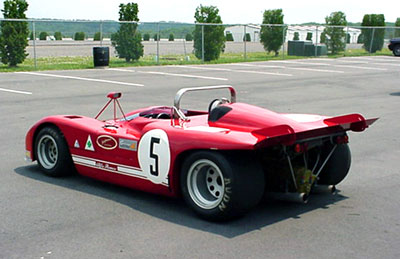
Nastasi's
T33/3 was built in late 1969, and according to Ed McDonough, was entered
at the Osterreichrng in Austria and driven by de Adamich/Vaccarella.
|
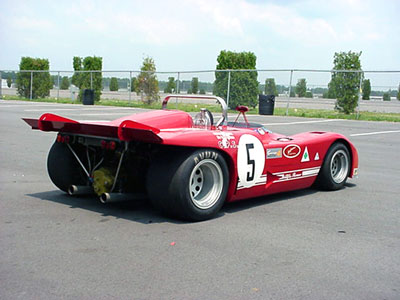
When Nastasi
purchased it in 1985, the car had been updated to 1971 specs. Here it is
in the livery of Vacarella's Targa Florio winning T33/3, although it is
unknown if this is the actual chassis used by Vaccarella.
|
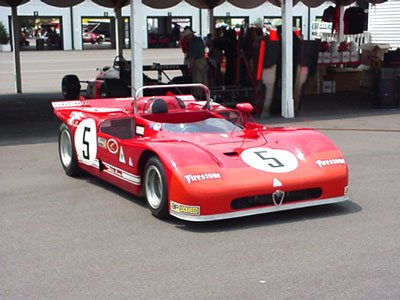
For most of its life, the T33/3 had to compete with the Group 5 (Porsche 917s and Ferrari 512s) cars for the Championship--but in 1971 the T33 won three Championship overall victories and placed second to Porsche in the World's Manufacturers Championship.
|
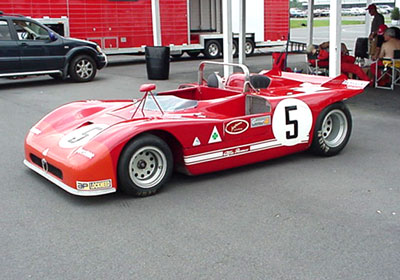
Henri Pescaralo, Rolf Stommelen, Nanni Galli, Nino Vaccarella, Andrea de Adamich, and many others raced the T33/3 and all were impressed by the car's handling and
strength.
|
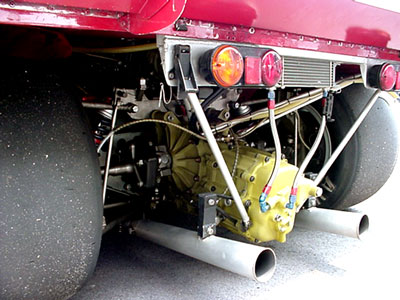
The DOHC four valve (gear driven) 2998cc V8 was powerful and reliable, and by
1971 was producing over 430 bhp. The 6 speed "long" transmission was used on the early 33's. Later when upgraded part of the upgrade package was the "short" 5 gear transmission.
|
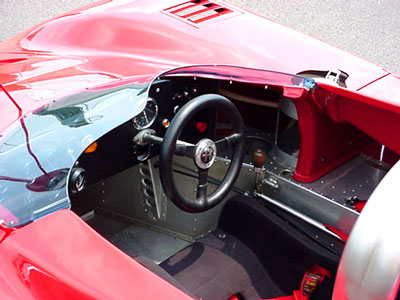
The monocoque chassis was described as "monocoque parallelled in aluminum and titanium." Of course, there were also the huge gas tanks on both sides of the driver.
|
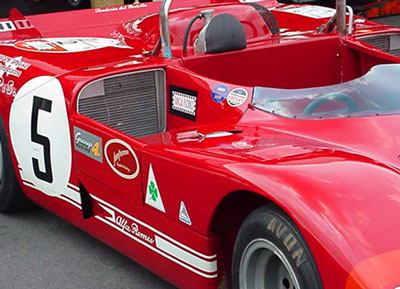
The early T33 had rear oil cooler and front radiator cooling. On upgrading it was reverses the oil cooler was in front and the 2 radiator coolers were in the front.
|
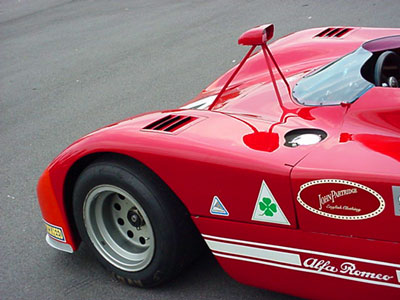
The Tipo 33/3 was almost a perfect race car. In 1972, the huge Group 5 cars
would disappear; Autodelta thought it had the Championship locked up.
But the new Ferrari 312PB would prove them wrong.
|
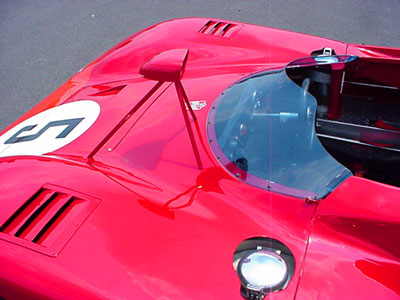
Engineers were just beginning to understand downforce as applied to the entire design. Once understood in terms of the sports car.
|
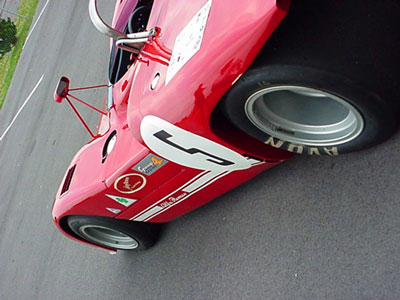
For the new Sportscar Championship in 1972, the T33/3 would be replaced
by a new car, the spaceframe T33/TT/3. Eventually, the Alfa T33 would win the sought after Championship in 1975 and again in 1977 with a flat twelve
installed in both tubular and monocoque chassis.
|



